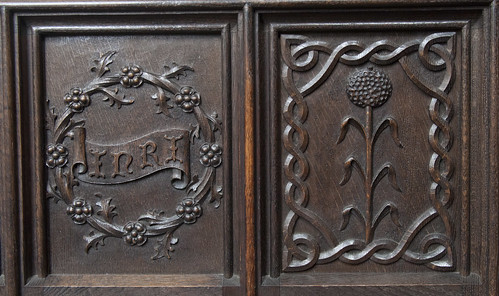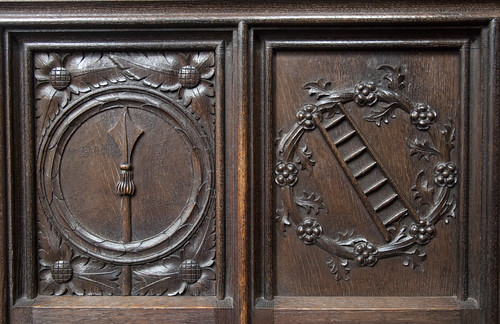 |
| The Seamless Garment; the dice used to gamble for it. |
1: Leon Podles' argument about masculinity.
2: How Podles thinks the Church became feminised in the High Middle Ages
3. Doubts about Podles' historical argument.
4. The role of Rationalism and Romanticism in confirming the feminine image of the Church.
5. The liturgy, and a solution to the problem.
The Enlightenment is a huge subject, but in the form in which it most affected the Catholic Church most directly it was Rationalist, and exulted Reason above the emotions. As time went on it was increasingly sceptical of religion, and in France it was associated with anti-clericalism. It took as its starting-point the Protestant separation of Faith and Reason. Since everything it didn't like was lumped together as anti-rational, the emotions and Faith became identified. The Church was associated with the feminine, and the feminine was denigrated.
A really clear illustration of this was the idea associated with Free Masonry: that the Lodge (all male, inspired by Enlightenment principles) was the place for men, and the Church was for women and children. The teachings of the Church, according to less overtly anti-clerical forms of Masonry, are literally false, but can be viewed as a way of teaching ethical truths to the less rational. (Something like this seems to have been the view of the philosopher Kant.)
The denigration of the emotions was never going to last long. The reaction came in the form of Romanticism, which exults the emotions and goes so far as to denigrate the intellect. Romanticism was the source of many conversions to the Church, since it allowed people to take seriously the promptings of the heart, the art, the music, and so on, at a time when the Church's intellectual engagement with the world was at a low ebb. But the rejection of reason and the reliance on spontaneous, subjective feelings as the ultimate arbiter of truth is, obviously, incompatible with the Church's teaching, as it is with common sense. It created the curious situation in which the Church could be simultaneously criticised for being emotional and anti-rational (by those influenced by Rationalism), and overly legalistic and unspontaneous (by Romantics).
 |
| The Titulus; an opium poppy, symbol of the drug offered, and refused, by Our Lord. |
As Rao points out, this is actually bad news for women - the real ones, that is. The message is that men were intrinsically over-intellectual, and were making a mess of things, and women were going to save the day. This might seem flattering, but in effect men are refusing to take on the risks involved in trying to solve the problems of the hour, and expecting women, placed on an absurd pedestal, to do it for them, precisely by virtue of their weakness and lack of rationality. One can have some sympathy with Feminism for rejecting this idea with such force. If we are being expected to save the world, they might justifiably say, then stop treating as though we are made of glass, and let us get on with the job on the same basis as men.
As far as attitudes to the Church and religion are concerned, the Rationalist relegation of religion to the non-rational, feminine, realm is not undone by Romanticism, but reinforced. Those most sympathetic to religion, who wanted to make use of Romantic ideas, would dig themselves even deeper into the hole. If we are expecting salvation from the feminine, then great, the Church is feminine, believers need to adopt feminine attitudes, and we can go into business as a feminine saviour of society. It is not difficult to see how this would take hold of the cult of Mary: instead of Our Lady being the image of the Church as a Community, she could become almost a substitute for the saving work of Christ.
Podles makes the very important point that are dealing with very subtle things: attitudes, habits of minds, one aspect of things being stressed at the expense of another, tiny changes in religious art. One touches them and they disintegrate in our fingers like cobwebs. Church authorities would intervene to stop anything clearly unorthodox, but the kind of subtle tendency which can make the Church appear a little too feminine, to those most sensitive to such things, namely very young men, need not be a matter of heresy. Such subtle factors are nevertheless self-reinforcing.
Podles' neglect of developments in secular philosophy has led him to place too much emphasis on factors internal to the Church, and assign too much blame to the spiritual masters of the High Middle Ages. These things, however, are not unconnected. The tradition of Bridal Mysticism and the Aristotelian analysis of the sexes made the Church a sitting duck for Rationalist and Romantic reinterpretations as a thoroughly feminine institution. The special situation of the Church in Britain and other parts of the English-speaking world may have kept this problem at bay up to the middle of the 20th century, despite the temptations towards sentimentalism one sees in popular devotional art, hymns, and devotional manuals from that period. But that is no longer the case: the English-speaking Church, just like the Church of the Spanish-speaking world, is today a male-led but female-dominated institution. How that happened needs explanation, and this is again something Podles doesn't give much space to.
But I expect my readers can think of something which happened in the Church just after the middle of the 20th century, which could be called on to explain the exodus of men. I'll discuss it tomorrow.
 |
| The Lance; the Ladder. |
No comments:
Post a Comment